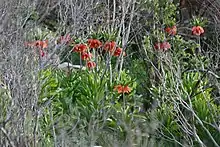Fritillaria imperialis
Fritillaria imperialis, the crown imperial, imperial fritillary or Kaiser's crown, is a species of flowering plant in the lily family Liliaceae, native to a wide stretch from the Anatolian plateau of Turkey, Iraq and Iran (i.e. Kurdistan[2][3][4]) to Afghanistan, Pakistan, Northern India and the Himalayan foothills.[5] It is also widely cultivated as an ornamental and reportedly naturalized in Austria, Sicily, and Washington State, USA.[6][5][7] The common names and also the epithet "imperialis", literally "of the emperor", refer to the large circle of golden flowers, reminiscent of an emperor's crown.[8]
| Fritillaria imperialis | |
|---|---|
.jpg.webp) | |
| Scientific classification | |
| Kingdom: | Plantae |
| Clade: | Tracheophytes |
| Clade: | Angiosperms |
| Clade: | Monocots |
| Order: | Liliales |
| Family: | Liliaceae |
| Subfamily: | Lilioideae |
| Tribe: | Lilieae |
| Genus: | Fritillaria |
| Species: | F. imperialis |
| Binomial name | |
| Fritillaria imperialis | |
| Synonyms[1] | |
|
Synonymy
| |
Description
Fritillaria imperialis grows to about 1 m (3 ft) in height, and bears lance-shaped, glossy leaves at intervals along the stem. It bears a prominent whorl of downward facing flowers at the top of the stem, topped by a 'crown' of small leaves, hence the name. While the wild form is usually orange-red, various colours are found in cultivation, ranging from nearly a true scarlet through oranges to yellow. The pendulous flowers make a bold statement in the late spring garden; in the northern hemisphere, flowering takes place in late spring, accompanied by a distinctly foxy odour that repels mice, moles and other small animals.[8][9]
Owing to its large size, F. imperialis is pollinated by the Eurasian blue tit, which makes it a rare example of ornithophily at northern latitudes.[10]
Cultivation
The species[11] and the yellow-flowered 'Maximea Lutea'[12] have both gained the Royal Horticultural Society's Award of Garden Merit.[13] Other cultivars in shades of red, yellow and orange, are available.
Like other members of the lily family, F. imperialis is susceptible to depredation by the scarlet lily beetle (Lilioceris lilii).[8]
Taxonomy
A few names have been coined for taxa once considered as belonging to Fritillaria imperialis but now regarded as distinct species:
- Fritillaria imperialis var. chitralensis, now called Fritillaria chitralensis
- Fritillaria imperialis var. eduardii, now called Fritillaria eduardii
- Fritillaria imperialis var. inodora, now called Fritillaria eduardii var. inodora
- Fritillaria imperialis var. inodora-purpurea, now called Fritillaria eduardii var. eduardii
Role in the culture of Iran
The flower has a long and deep connection with the history, religion, mythology and folklore of its native Iran and, as a result, has acquired a wealth of evocative vernacular names, often referencing the pendent form of the blossoms and the tear-like nectar drops borne by the six nectaries. In Iranian folklore the nodding flowers are described (in comparison with the upright flowers of tulips) as being 'upside-down', this curious posture being attributed to the plant's bowing its (originally upright) 'head' in sorrow upon the death of a mythological or religious personage. Likewise, the glistening drops of nectar at the base of each flower are described as the tears which the plant weeps in mourning the departed. Depictions of the distinctive inflorescences may be seen on the sculpted capitals of Sassanid columns, as at Taq-e Bostan. F. imperialis is linked to the legend of the tragic death of Siyâvash, (a semi-divine hero in Ferdowsi's prodigious national epic Shahnameh) - whence the common name Ashk-e Sivash ('Tear of Siyâvash').[14][15]
Gallery
%252C_Jard%C3%ADn_Bot%C3%A1nico%252C_M%C3%BAnich%252C_Alemania_2012-04-21%252C_DD_01.JPG.webp) Fritillaria imperialis in botanic garden, Germany
Fritillaria imperialis in botanic garden, Germany 'Rubra Maxima'
'Rubra Maxima' Kurdistan, Iran
Kurdistan, Iran Kurdistan, Iran
Kurdistan, Iran Kurdistan, Iran
Kurdistan, Iran.JPG.webp) View of the whole plant
View of the whole plant Keukenhof, Lisse, Netherlands
Keukenhof, Lisse, Netherlands Charlottenburg Palace garden
Charlottenburg Palace garden Fritillaria imperials in Siirt, Turkey
Fritillaria imperials in Siirt, Turkey Illustration in John Edwards, The British Herbal 1769
Illustration in John Edwards, The British Herbal 1769 Khansar, Iran. This picture shows the six nectaries, dark spots each with a drop of nectar.
Khansar, Iran. This picture shows the six nectaries, dark spots each with a drop of nectar.
References
- The Plant List
- Kiani, Mahmoud; Mohammadi, Shirin; Babaei, Alireza; Sefidkon, Fatemeh; Naghavi, Mohamad Reza; Ranjbar, Mojtaba; Razavi, Seyed Ali; Saeidi, Keramatollah; Jafari, Hadi; Asgari, Davoud; Potter, Daniel (2017-10-01). "Iran supports a great share of biodiversity and floristic endemism for Fritillaria spp. (Liliaceae): A review". Plant Diversity. 39 (5): 245–262. doi:10.1016/j.pld.2017.09.002. ISSN 2468-2659. PMC 6112302. PMID 30159518.
- Pieroni, Andrea; Zahir, Hawre; Amin, Hawraz Ibrahim M.; Sõukand, Renata (2019-11-27). "Where tulips and crocuses are popular food snacks: Kurdish traditional foraging reveals traces of mobile pastoralism in Southern Iraqi Kurdistan". Journal of Ethnobiology and Ethnomedicine. 15 (1): 59. doi:10.1186/s13002-019-0341-0. ISSN 1746-4269. PMC 6882212. PMID 31775812.
- Sharifi-Tehrani, M., Advay, M., & Shabani, L. (2015). "Fritillaria (Liliaceae) in Iran: distribution and Nomenclature". Taxonomy and Biosystematics. 22 (7): 49–70.
{{cite journal}}: CS1 maint: multiple names: authors list (link) - Kew World Checklist of Selected Plant Families
- Altervista Flora Italiana, Meleagride imperiale, Fritillaria imperialis L.
- Biota of North America Program 2014 county distribution map
- RHS A-Z encyclopedia of garden plants. United Kingdom: Dorling Kindersley. 2008. p. 1136. ISBN 978-1405332965.
- Linnaeus, Carl. 1753. Species Plantarum 1: 303
- Duthie, David (9 September 1989), "Bluetits pollinate the plants other creatures cannot reach", New Scientist, retrieved 16 April 2021
- "Fritillaria imperialis". RHS. Retrieved 27 February 2020.
- "Fritillaria imperialis 'Maximea Lutea'". RHS. Retrieved 27 February 2020.
- "AGM Plants - Ornamental" (PDF). Royal Horticultural Society. July 2017. p. 39. Retrieved 27 February 2018.
- https://www.visitiran.ir/attraction/plain-overturned-tulips-fritillaria Retrieved at 12.10 on 16/6/21
- https://www.heritageinstitute.com/zoroastrianism/pdf/usefulPlantsOfIranIraq.pdf Retrieved at 00.08 on 17/6/21
